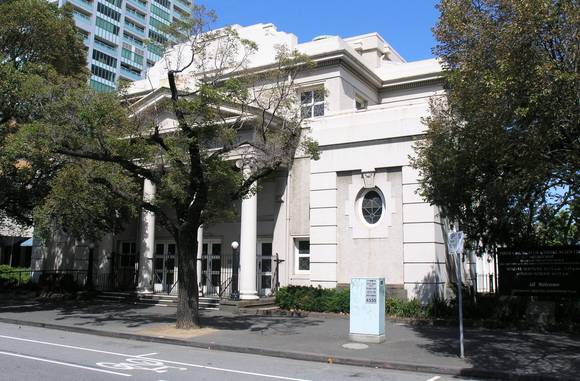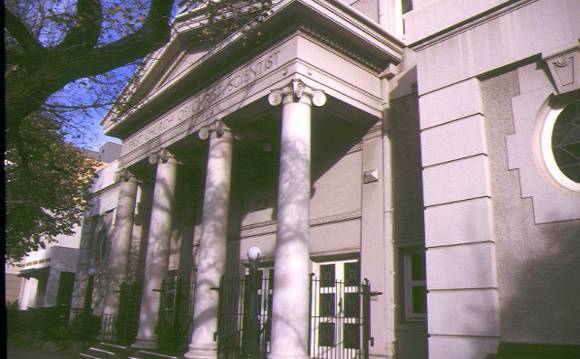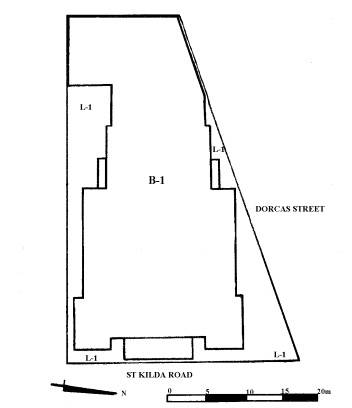| Back to search results » | Back to search page » |
|
FIRST CHURCH OF CHRIST, SCIENTIST, MELBOURNE
Location336-340 ST KILDA ROAD MELBOURNE, PORT PHILLIP CITY
File Number601728LevelRegistered |
|
Statement of Significance
What is significant?
Christian Science services in Australia began in Melbourne in 1898. First Church of Christ, Scientist, Melbourne was established in 1903 with its services being held in the Athenaeum Hall until the opening of First Church in St Kilda Road. Members of the church purchased the St Kilda Road site in 1914 and engaged the architects Bates, Peebles & Smart to prepare plans for a church and Sunday School. Harold Dumsday was responsible for the design. The plans were held over during the First World War and work did not commence by contractors Hansen & Yuncken until 1920. The foundation stone was laid on 21 December 1920 and the formal opening was on 7 May 1922. In 1928 a Willis organ was added at a cost of £7,500. In 1934 a new block containing offices was added to the rear of the building, facing Dorcas Street. This was designed by the original architects, (then known as Bates, Smart and McCutcheon) to harmonise with the church building.
Harold Dumsday designed the church in a "Neo-Grec" style. The church has a temple-like form with Greek Revival elements but also reflects Byzantine influences with its Diocletian windows and shallow copper-topped dome. The main facade to St Kilda Road has a central pedimented Ionic portico, flanked by projecting parapeted pavilions. The building is finished in roughcast render with smooth rusticated piers and cornice mouldings. The building is double-storeyed with the church auditorium located on the upper storey and the Sunday School on the lower storey. The building features a timber-lined hydraulic lift (still in use) The flooring throughout is polished hardwood and the seating and dado are in Pacific maple.
The 1934 block is a flat-roofed building with walls finished in textured cement stucco with a show window facing onto Dorcas Street. The building contains a basement and an upper storey.
How is it significant?
First Church of Christ, Scientist, Melbourne is of architectural and historical significance to the state of Victoria.
Why is it significant?
First Church of Christ, Scientist, Melbourne is architecturally significant as a fine and rare example of early twentieth century classicism applied to an ecclesiastical building in Victoria. The architect Harold Dumsday of Bates, Peebles and Smart, influenced by contemporary British architects, designed this distinctive version of the "Neo-Grec" style. Classical references include the columned portico of the front facade, mosaic and terrazzo porch floor, the Greek Revival leadlight to the front doors and the wrought iron light posts that originally held torches. The dome and the Diocletian windows give a distinctively Byzantine feel to the building. The exterior and interior of the church have a high level of integrity, retaining original features such as light fittings, pews, heaters, built-in lecterns, decorative organ screen and
hydraulic lift.
First Church of Christ, Scientist, Melbourne is historically significant as the first church of the Christian Science movement in Victoria. In 1879, in Boston, Massachusetts, the Christian Scientist Association on motion of Mary Baker Eddy, the founder of the Christian Science movement, voted to organise a church. This church was re-organised in 1892 and named The First Church of Christ, Scientist. The Mother Church building in Boston was erected in 1894. First Church of Christ, Scientist, Melbourne reflects the distinctive requirements of the Christian Science movement with its three functional units: the church, the Sunday School and the administration block. The hydraulic lift is an unusual feature in a church building. The built-in lecterns in the church auditorium and the readers' rooms off the rostrum reflect the Christian Science requirement for two elected readers. The simplicity and elegance of the Sunday School and the church with its auditorium-like plan and its rostrum reflects the Christian Science tradition for simple sincerity of form and feeling.
Group
Religion
Category
Church






